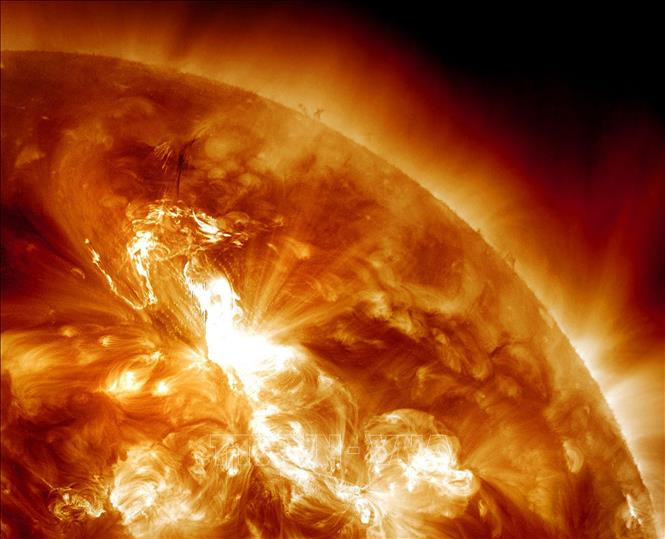The world as well as Vietnam has been affected by the strongest solar storm (also known as magnetic storm) in two decades.

A magnetic storm hitting Earth has created spectacular aurora light shows in the sky but also threatens to disrupt satellites and power grids as the storm is expected to last through the weekend.
Magnetic storms directly affect Vietnam
According to Associate Professor, Dr. Ha Duyen Chau, former Director of the Institute of Geophysics, Vietnam Academy of Science and Technology, a magnetic storm is a strong change in the Earth's magnetic field. When the Sun is very active, dark spots appear on the surface of the Sun. From these dark spots, solar chromosphere explosions occur, releasing plasma beams into space (called solar plasma chromosphere beams). They include electrically neutral elements, which will affect the Earth, cover the entire Earth and disrupt the magnetic field system. It is called a storm but it exists invisible, cannot be detected by the naked eye and only causes specific impacts.
On May 10, a huge magnetic storm occurred on Earth, which scientists assessed as “the strongest in the past 20 years”. This magnetic storm was at level 5 (G5), the strongest level on the magnetic storm scale, directly affecting Vietnam. Solar activity changes in an 11-year cycle. The most recent maximum solar activity was in 2014.
Magnetic storms have a negative impact on human health because they strongly impact the nervous and cardiovascular systems. Scientists have determined that when magnetic storms occur, heart rate and blood pressure increase significantly, especially in the elderly.
Scientists also estimate that during this period, white blood cells in the blood of all animals are reduced and there is a correlation between many epidemics and the strong cycle of magnetic storms such as: cholera, plague, flu, typhoid, meningitis... However, magnetic storms do not affect normal people. Magnetic storms only directly affect people with neurological or cardiovascular diseases or people who are sensitive to magnetism. The effects of storms often cause fatigue, restlessness, and can even lead to death.
Improving the quality of magnetic storm research
According to Associate Professor, Doctor Ha Duyen Chau, in many countries around the world, during days of magnetic storms, patients sensitive to magnetic fields, especially cardiovascular and neurological patients, are placed in anti-magnetic houses (Faraday cages) to prevent the effects of magnetic storms. In Vietnam, there are currently no conditions to build such anti-magnetic houses, so more regular monitoring and care is needed.
For large power transmission systems, to prevent magnetic storms, many countries have also taken many specific measures, such as: Setting new values for the protection system (relay system), announcing magnetic storm forecasts, monitoring AC voltage asymmetry, and reducing operating capacity when receiving magnetic storm forecasts.
Associate Professor, Dr. Nguyen Xuan Anh, Director of the Institute of Geophysics, Vietnam currently has a system of four geomagnetic stations to record magnetic variations, magnetic storms as well as serve the research and forecasting of storms. These four stations are located in Phu Thuy (Gia Lam, Hanoi), Sa Pa (Lao Cai), Da Lat (Lam Dong) and Bac Lieu (Bac Lieu province). However, currently only two stations in Phu Thuy and Da Lat are capable of transmitting data directly to the Institute of Geophysics as well as internationally. In Vietnam, the task of continuously observing the Earth's magnetic field and making long-term forecasts (about 30 days) has only been carried out. Research on short-term magnetic storm forecasts (about 30 minutes/day) has not been carried out due to insufficient equipment and data.
“With state investment and international cooperation, the Institute of Geophysics is planning to upgrade stations and stations collecting geomagnetic and ionomagnetic data with modern digital magnetic recording equipment to improve the quality of geomagnetic field research and forecasting of magnetic storms. In the near future, the Institute will cooperate with Japan to repair magnetic field recording equipment at the station in Bac Lieu. Meanwhile, the stations in Sa Pa using photomechanical magnetic recorders (using photographic paper) are gradually being modernized with digital magnetic recorders,” Associate Professor, Dr. Nguyen Xuan Anh added.